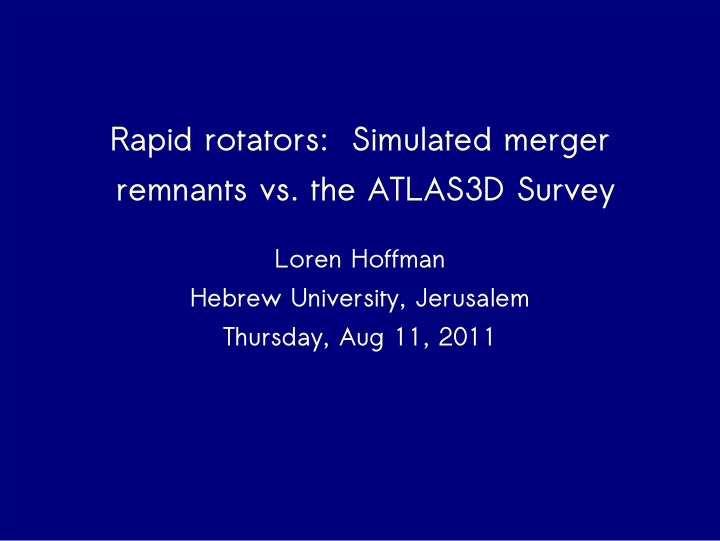

Rapid rotators: Simulated merger remnants vs. the ATLAS3D Survey Loren Hoffman Hebrew University, Jerusalem Thursday, Aug 11, 2011
- Predecessor: SAURON survey – High-resolution IFS of ~50 nearby early-type galaxies within ~ 1 effective radius; Revealed a variety of kinematic structures, such as kinematic twists and KDCs - ATLAS3D: Representative, volume-limited sample of 260 early-type galaxies with D < 42 Mpc, designed to probe the dominant S0 and elliptical formation mechanisms; Parallel simulation effort ATLAS I: Cappellari et al. 2011
Krajnovic et al. 2011 (ATLAS II): We find that 71 per cent of nearby early-type galaxies are strictly aligned systems (Psi 5 degrees), ≤ an additional 14 per cent have 5 deg < Psi 10 deg, and 90 per cent of galaxies have Psi 15 deg. ≤ ≤ Taking into account measurement uncertainties, 90 per cent of galaxies can be considered aligned to better than 5 deg, suggesting that only a small fraction of early-type galaxies ( 10 per cent) are not ∼ consistent with the axisymmetry within the projected half-light radius. We use KINEMETRY to analyse the mean velocity maps and separate galaxies into two broad types of regular and non-regular rotators. We find 82 per cent of regular rotators and 17 per cent of non-regular rotators … Taking into account the kinematic alignment and the kinemetric analysis, the majority of early-type galaxies have velocity maps more similar to that of the spiral discs than to that of the remnants of equal-mass mergers. We suggest that the most common formation mechanism for early-type galaxies preserves the axisymmetry of the disc progenitors and their general kinematic properties. Less commonly, the formation process results in a triaxial galaxy with much lower net angular momentum. Emsellem et al. 2011 (ATLAS III): We show that the vast majority of ETGs are fast rotators: these have the regular stellar rotation, with aligned photometric and kinematic axes (Paper II of this series), include discs and often bars and represent 86 ± 2 per cent (224/260) of all ETGs in the volume-limited ATLAS3D sample … We … argue for a shift in the paradigm for ETGs, where the vast majority of ETGs are galaxies consistent with nearly oblate systems (with or without bars) and where only a small fraction of them (less than 12 per cent) have central (mildly) triaxial structures.
The variety among RRs
How to make RR's in major mergers? 1) High enough gas fraction (e.g. Robertson et al. 2006, Hopkins et al. 2009)
2) Low enough mass ratios (e.g. Bournaud et al. 2005, Johansson et al. 2009)
3) Wide enough orbit, with a massive enough bulge (e.g. Barnes 1992, Novak et al. 2006)
Intrinsic shapes and kinematic misalignments
Rapid rotation is the norm, in ATLAS3D and in theoretical modeling
Kinemetric vs. photometric flattening
Higher-order moments of the LOSVDs
Explanation for the shapes of the h3,4 – v / sigma diagrams
Radial variation of the angular momentum
Large kinematic twists in the highly dissipative remnants
Speculation for the next project – phase space signatures of galaxy formation
Conclusions Broadly speaking, both observations and theory support the aligned, rapid rotator as the generic outcome of early-type galaxy formation. Using the goldmine of kinematic information available in ATLAS3D and other 2D kinematic surveys (particularly those probing larger radii – talk to e.g. Aaron and Jean) we may soon be able to identify the most common mechanisms of early-type galaxy formation.
Recommend
More recommend